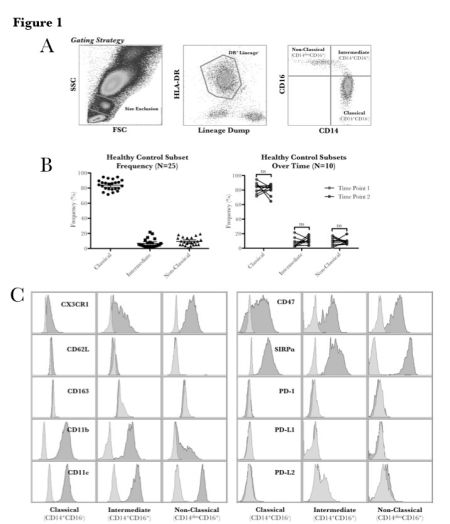Characterization of Human Monocyte Subsets
Starzl Transplantation Institute, Department of Surgery, University of Pittsburgh, Pittsburgh, PA
Meeting: 2013 American Transplant Congress
Abstract number: C1290
Monocytes are the dominant cell population infiltrating renal allografts early after transplantation, and monocyte-mediated graft dysfunction has been observed following T cell depletion. Monocytes have been grouped into classical (CD14+CD16-), non-classical (CD14dimCD16+), and intermediate (CD14+CD16+) subsets (Figure 1A). The role of these subsets in transplantation is poorly understood.
Methods. Phenotyping was performed in whole blood from 25 healthy subjects. For functional studies monocyte subsets were sorted from healthy human leukapheresis products. Each subset was stimulated with agonists for TLRs 1-9 prior to cytokine profiling. Monocyte subsets were induced to differentiate to dendritic cells (DC) with GM-CSF and IL-4 for 1 week.
Results. Frequencies of monocyte subsets: 83.95% classical (95% CI 81.12 to 86.78), 6.65% intermediate (4.32 to 8.99), and 9.28% non-classical (7.12 to 11.44). A subsample were re-phenotyped 4-6 months later; subset frequencies were not different (p = 0.95) (Figure 1B). Representative phenotyping is shown in Figure 1C.

Subsets were distinct in their secretion of inflammatory cytokines (Figure 2A). When subsets were recombined in physiologic ratios, cytokine secretion was suppressed. After induction to DC differentiation, classical monocytes (red histograms) acquired DC markers (Figure 2B) and morphology; intermediate (blue histograms) and non-classical monocytes (green histograms) did not.

Monocyte subsets display differing phenotype and functional properties. They populate the monocyte compartment in tightly controlled ratios over time and across healthy individuals. Classical monocytes appear to be the principal source of antigen-presenting DCs. Non-classical monocytes suppress secretion of inflammatory cytokines by classical and intermediate monocytes in mixed cultures.
To cite this abstract in AMA style:
Boyette L, Macedo C, Elinoff B, Metes D, Lakkis F. Characterization of Human Monocyte Subsets [abstract]. Am J Transplant. 2013; 13 (suppl 5). https://atcmeetingabstracts.com/abstract/characterization-of-human-monocyte-subsets/. Accessed December 14, 2025.« Back to 2013 American Transplant Congress
